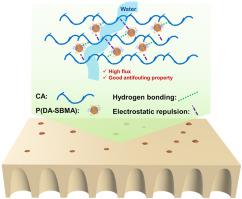当前位置:
X-MOL 学术
›
J. Membr. Sci.
›
论文详情
Our official English website, www.x-mol.net, welcomes your feedback! (Note: you will need to create a separate account there.)
Increased performance and antifouling of mixed-matrix membranes of cellulose acetate with hydrophilic nanoparticles of polydopamine-sulfobetaine methacrylate for oil-water separation
Journal of Membrane Science ( IF 9.5 ) Pub Date : 2021-02-01 , DOI: 10.1016/j.memsci.2020.118881 Manuel Reyes De Guzman , Chester Kenneth A. Andra , Micah Belle Marie Yap Ang , Gian Vincent C. Dizon , Alvin R. Caparanga , Shu-Hsien Huang , Kueir-Rarn Lee
Journal of Membrane Science ( IF 9.5 ) Pub Date : 2021-02-01 , DOI: 10.1016/j.memsci.2020.118881 Manuel Reyes De Guzman , Chester Kenneth A. Andra , Micah Belle Marie Yap Ang , Gian Vincent C. Dizon , Alvin R. Caparanga , Shu-Hsien Huang , Kueir-Rarn Lee

|
Abstract Emerging technologies for treating oily wastewater employ ultrafiltration membranes that incorporate hydrophilic nanoparticles for enhanced effectiveness and efficiency. In this study, cellulose acetate (CA) mixed-matrix membranes with zwitterionic nanoparticles—polydopamine-sulfobetaine methacrylate or P(DA-SBMA)—were fabricated through wet-phase inversion. The ratio of SBMA to DA monomers was varied to alter the size of P(DA-SBMA) nanoparticles. Adding P(DA-SBMA) to the CA solution led to thermodynamic instability, which resulted in turn in instantaneous demixing during the phase separation in water. The effect was favorable on the membrane porosity and mean pore radius. Moreover, the membrane hydrophilicity was improved because of the abundance of hydrophilic functional groups present in P(DA-SBMA) nanoparticles. A suitable size and content of P(DA-SBMA) nanoparticles embedded in the CA matrix produced a modified CA membrane that delivered optimal water flux of 583.64 ± 25.12 L m−2 h−1. The flux recovery and reversible fouling were enhanced by 8.85% and 11.10%, respectively, whereas the irreversible fouling decreased by 8.85%. Different oil-in-water emulsions containing diesel oil, dodecane, food-grade oil, toluene, and hexane were subjected to tests, and high separation efficiencies (95–99%) were achieved. Overall, the fabricated membranes were effective in treating different types of oily wastewater.
中文翻译:

具有聚多巴胺-磺基甜菜碱甲基丙烯酸酯亲水性纳米颗粒的醋酸纤维素混合基质膜提高油水分离性能和防污性
摘要 处理含油废水的新兴技术采用超滤膜,其中包含亲水性纳米颗粒以提高有效性和效率。在这项研究中,具有两性离子纳米粒子——聚多巴胺-磺基甜菜碱甲基丙烯酸酯或 P(DA-SBMA)——的醋酸纤维素 (CA) 混合基质膜是通过湿相转化制备的。改变 SBMA 与 DA 单体的比例以改变 P(DA-SBMA) 纳米颗粒的尺寸。将 P(DA-SBMA) 添加到 CA 溶液中会导致热力学不稳定,进而导致在水中的相分离过程中发生瞬时分层。该效果对膜孔隙率和平均孔半径是有利的。此外,由于 P(DA-SBMA) 纳米粒子中存在大量亲水性官能团,因此膜亲水性得到改善。嵌入 CA 基质中的 P(DA-SBMA) 纳米颗粒的合适尺寸和含量产生了一种改良的 CA 膜,该膜提供了 583.64 ± 25.12 L m-2 h-1 的最佳水通量。助焊剂回收率和可逆污垢分别提高了 8.85% 和 11.10%,而不可逆污垢减少了 8.85%。对含有柴油、十二烷、食品级油、甲苯和己烷的不同水包油乳液进行了测试,实现了高分离效率(95-99%)。总体而言,制造的膜可有效处理不同类型的含油废水。而不可逆污垢减少了8.85%。对含有柴油、十二烷、食品级油、甲苯和己烷的不同水包油乳液进行了测试,实现了高分离效率(95-99%)。总体而言,制造的膜可有效处理不同类型的含油废水。而不可逆污垢减少了8.85%。对含有柴油、十二烷、食品级油、甲苯和己烷的不同水包油乳液进行了测试,实现了高分离效率(95-99%)。总体而言,制造的膜可有效处理不同类型的含油废水。
更新日期:2021-02-01
中文翻译:

具有聚多巴胺-磺基甜菜碱甲基丙烯酸酯亲水性纳米颗粒的醋酸纤维素混合基质膜提高油水分离性能和防污性
摘要 处理含油废水的新兴技术采用超滤膜,其中包含亲水性纳米颗粒以提高有效性和效率。在这项研究中,具有两性离子纳米粒子——聚多巴胺-磺基甜菜碱甲基丙烯酸酯或 P(DA-SBMA)——的醋酸纤维素 (CA) 混合基质膜是通过湿相转化制备的。改变 SBMA 与 DA 单体的比例以改变 P(DA-SBMA) 纳米颗粒的尺寸。将 P(DA-SBMA) 添加到 CA 溶液中会导致热力学不稳定,进而导致在水中的相分离过程中发生瞬时分层。该效果对膜孔隙率和平均孔半径是有利的。此外,由于 P(DA-SBMA) 纳米粒子中存在大量亲水性官能团,因此膜亲水性得到改善。嵌入 CA 基质中的 P(DA-SBMA) 纳米颗粒的合适尺寸和含量产生了一种改良的 CA 膜,该膜提供了 583.64 ± 25.12 L m-2 h-1 的最佳水通量。助焊剂回收率和可逆污垢分别提高了 8.85% 和 11.10%,而不可逆污垢减少了 8.85%。对含有柴油、十二烷、食品级油、甲苯和己烷的不同水包油乳液进行了测试,实现了高分离效率(95-99%)。总体而言,制造的膜可有效处理不同类型的含油废水。而不可逆污垢减少了8.85%。对含有柴油、十二烷、食品级油、甲苯和己烷的不同水包油乳液进行了测试,实现了高分离效率(95-99%)。总体而言,制造的膜可有效处理不同类型的含油废水。而不可逆污垢减少了8.85%。对含有柴油、十二烷、食品级油、甲苯和己烷的不同水包油乳液进行了测试,实现了高分离效率(95-99%)。总体而言,制造的膜可有效处理不同类型的含油废水。



























 京公网安备 11010802027423号
京公网安备 11010802027423号